SPECIAL TOOLS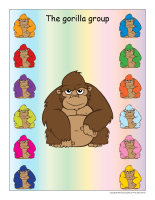
This tool was created in response to a special request received. (Open group identification-Monkeys) Print. Use the items to decorate your daycare and identify children's items.
CIRCLE TIME
Poni discovers and presents-Monkeys
(Open Poni discovers and presents-Monkeys) Print and laminate the cards. Using a Poni puppet or another puppet children are familiar with, present the different types of monkeys to your group.
AREA SETUP
Thematic poster-Monkeys
(Open thematic poster-Monkeys) Print and use the poster to decorate your daycare and announce your theme.
Educa-theme-Monkeys
(Open educa-theme-Monkeys) Print and laminate the different elements representing the theme. Use them to present the theme to your group (and children’s parents) while decorating your daycare.
Educa-decorate-Monkeys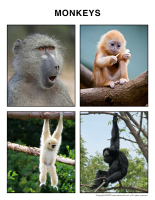
(Open educa-decorate-Monkeys) Print, laminate, and cut out the illustrations. Use them to decorate your walls or hang them from the ceiling.
PICTURE GAME
The pictures may be used as a memory game or to spark a conversation with your group. Use them to decorate your daycare or a specific thematic corner. (Open picture game-Monkeys) Print, laminate, and store in a Ziploc bag or thematic bin.
ACTIVITY SHEETS
(Open activity sheets-Monkeys) Print and follow instructions.
WRITING ACTIVITIES
(Open writing activities-M like monkey) Print for each child or laminate for use with a dry-erase marker.
Stationery-Monkeys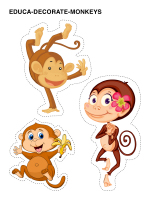
(Open stationery-Monkeys) Print and use the stationery to communicate with parents, in your reading and writing area, or to identify your thematic bins.
LANGUAGE ACTIVITIES
Word flashcards
Use the flashcards to spark a conversation with your group or in your reading and writing area. They may also be used to identify your thematic bins. (Open word flashcards-Monkeys) (Open giant word flashcards-Monkeys) Print. Monkey, tail, louse, banana, gorilla, to climb, jungle, tree, liana, branch, brown, cage
Scene-At the zoo
(Open scene-At the zoo) Print, laminate, and cut the items. Children use them to decorate the scene.
ROUTINES AND TRANSITIONS
Game-This is my spot-Monkeys
(Open game-This is my spot-Monkeys) Print two copies. Laminate and cut out the cards. Glue one copy of each card on the table using adhesive paper. Drop the copies in a bag. Children take turns picking a card to determine their spot at the table for the day. You may also use the cards to determine naptime spots or for your task train.
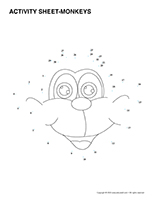
My monkey path
(Open my monkey path) Print, laminate, and secure the illustrations on the floor to create a path which leads to areas frequently visited by children such as the bathroom or cloakroom. If you prefer, the illustrations may also be used to delimit your various workshops.
VARIOUS WORKSHOPS-Jungle
Construction (building blocks)
- Decorate your construction area with pictures of different zoo animals. You can, for example, use pictures from dollar store calendars.
- Set different animal figurines in your area: wild animals, aquatic animals, polar animals, farm animals, reptiles, zoo animals, etc.
- Add figurines that will represent people who visit the zoo!
- Children will love using LEGO blocks to build a variety of shelters and cages for animals.
- Set a zoo-themed rug on the floor.
Arts & crafts
- Popsicle sticks and white glue for creating cages for animals.
- Orange, yellow, brown, and black construction paper along with empty toilet paper rolls for creating animals or simple collages related to the theme.
- Old magazines (for example National Geographic) that children can cut animals out of to create a giant collage.
- Strips of orange, black, brown, and white paper that can be used to represent children’s favorite animals.
- Feathers that can be used to paint a bird.
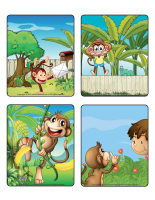
Drawing
- Coloring pages representing animals that we see at the zoo and zookeepers.
- Wild animal stencils.
- Brown construction paper that children can draw monkeys on.
- Pictures of monkeys and other animals along with tracing paper.
- A sheet of paper divided into 2 parts with a monkey in one section that children must reproduce in the other section.
Role play
- Represent a zoo ticket booth and encourage children to step up to it to purchase their ticket to visit the zoo. To represent a zoo, display posters on the walls and set stuffed zoo animals throughout your role play area.
- Pretending to be a zookeeper will be a popular activity throughout the theme. Provide a shirt, brown pants, a hat, a flashlight, a set of keys, a cell phone, etc.
- There is always a veterinarian at the zoo. Add a white shirt, a stethoscope, a flashlight, a magnifying glass, syringes, bandages, etc.
- Encourage children to pretend they are cooks working at the zoo who prepare food for the monkeys and other animals.
- Encourage children to pretend they are cleaning out cages at the zoo. Provide work clothes, buckets, brushes, brooms, etc.
- Create an original habitat for monkeys using cardboard boxes.
- Makeup pencils.
Manipulation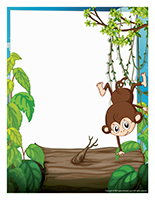
- A memory game using Educatall picture game illustrations or a store-bought version related to the theme.
- Modeling dough and animal-shaped cookie cutters.
- Several different types of fabric and fake fur to explore and touch.
- Lotto game or other board games related to the theme.
- Association game where children must match animals to their tracks.
- Zoo-themed puppets and a puppet theater.
Pre-reading
- Books about animals.
- Storybooks containing different zoo animals.
- A poster representing different animal families.
- A game where children must associate various animal sounds with pictures of animals.
- A map with pictures of animals that can be associated with various continents.
Pre-writing
- Connect-the-dot activities to draw monkeys or other animals.
- Animal outlines that can be traced.
- Mazes.
- Various activity sheets that involve identifying animals.
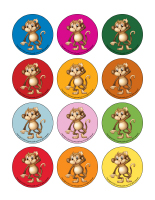
Motor skills
- An obstacle course where children must imitate a monkey, a lion, a seal, etc.
- Exercises involving jumping through hoops like lions.
- A balance beam for balancing like a tiger or a panther.
- An imitation game where children sit with a friend who performs various monkey moves and actions for his partner to mirror.
- Create your own “Feed the animal” game-a homemade bean bag toss game where children must toss bean bags into a monkey’s mouth.
- Instead of “Simon says…”, play a game of “Monkey says…”.
- Slither like snakes under chairs or throughout an obstacle course.
Sensory bins
- A water table that contains plastic animal figurines is always fun. Children will enjoy bathing the animals.
- A water table filled with ice cubes and polar animal figurines.
- A cereal bin (animal food) and small items that can hidden in the cereal.
Early science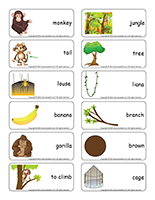
- Magnifying glasses to observe and study animal pictures and figurines up close.
- A bowl of water for each child so they can experiment drinking like an animal.
Kitchen
- Frozen bananas on a stick (dipped in chocolate if you wish) for a monkey-themed snack or dessert.
- A lunch where children can eat like animals, without utensils!
PHYSICAL ACTIVITY AND MOTOR SKILLS
Lacing-Monkeys
(Open lacing-Monkeys) Print, laminate, and punch holes around the models. Children thread ribbon or string through the holes.
Can you identify the animal?
Each child picks an animal (they can use a picture game or figurines for inspiration). They take turns hiding their picture or figurine in their hands and describing their animal (or imitating actions associated with it). The first child who correctly identifies an animal can be the next one to give clues pertaining to his own animal.
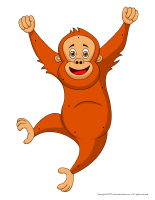
In the jungle, there are…
Have children stand in a circle. Give each child a different animal (lion, zebra, elephant, giraffe, cheetah, gorilla, etc.). Stand in the center of the circle and toss a scarf up in the air as you say, “In the jungle, there are…” Name an animal to complete the sentence. The child who was given this animal, must catch the scarf before it touches the ground and toss it back up into the air, naming another animal.
Monkey silliness
Pick a child who will be the monkey. The other children are gorillas. They must lie down on their side, with their eyes open and a serious look on their face. The child who was chosen to be the monkey walks around the gorillas making silly faces. When the gorillas laugh, they are eliminated. The last serious gorilla wins and gets to be the monkey for the next round.
Banana game
Ask your little monkeys to bring you as many objects that are yellow like a banana as possible within a predetermined period of time, for example 3 minutes.
I am a monkey
Like silly monkeys, children must imitate your every move (examples: hop on one leg, make a silly face, scratch their head, dance, scream, laugh, fall on their rear end, etc.). Variation: This game may also be done at lunch time. Use it to encourage children to eat unpopular vegetables. Your little monkeys must eat the same foods as you: one broccoli floret, a spoonful of corn, a cherry tomato, etc.
OUTDOOR ACTIVITIES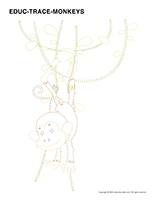
The monkeys follow the gorilla
Have children stand in a line. The first child in line is the gorilla. The gorilla executes different actions. The monkeys must follow along, repeating his every move. The gorilla can, for example, hop, perform a somersault, raise his arms over his head, crawl on all fours, clap, slither across the floor, etc.
Monkey game
Monkeys swing and jump from one branch to another. Have children practice different jumps: on one foot, with their feet together, big jumps, small jumps, etc. Repeat each exercise using jumping ropes or jute bags.
Follow the zookeeper
You are the zookeeper. Children stand in a line, one behind the other. Begin with easy moves, for example three steps forward, two steps to the right, one kangaroo hop. After a while, increase the level of difficulty. You could ask children to back up, walk on their tiptoes so they are tall like a giraffe, take one giant step forward like an elephant, etc.
COGNITIVE ACTIVITIES
Educ-trace-Monkeys
(Open educ-trace-Monkeys) Print for each child. Children trace the dotted lines using a crayon of the corresponding color. They can also color the object at the end of each dotted line using the same color.
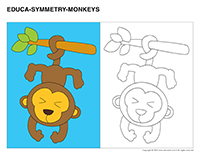
Educa-symmetry-Monkeys
(Open educa-symmetry-Monkeys) Print. Children must color the picture on the right (black and white) to reproduce the picture on the left (in color).
Educ-pairs-Monkeys
(Open educ-pairs-Monkeys) Print. Children must draw a line between identical monkeys or, if you printed the document in black and white, they can color identical monkeys using the same color. For durable, eco-friendly use, laminate for use with dry-erase markers.
Educ-intruder-Monkeys
(Open educ-intruder-Monkeys) Print and laminate. Children must find the 6 intruders in the scene.
Color by number-Monkeys
(Open color by number-Monkeys) Print for each child. Children must color the picture per the color code.
MORAL AND SOCIAL ACTIVITIES
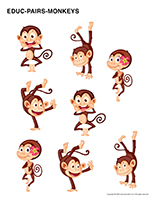
Silly monkeys
Set mirrors on a table. Encourage children to make all kinds of silly faces. Organize a contest and have children vote for the silliest monkey.
I am a…
Children take turns acting out a certain animal. You can whisper a type of animal in their ear or discreetly show them a picture of an animal.
CULINARY ACTIVITIES
Food item of the week: Bananas
(Open educ-poster-Banana) Print and laminate the poster and cards and use them to present the food item of the week to your group. Children will discover different ways they can enjoy bananas. Display the pictures where children eat or next to your play kitchen.
Little monkey cakes
Prepare chocolate cupcakes and have children spread chocolate icing on them once they have cooled. Using small vanilla wafers, they can add monkey ears and a monkey nose to each cupcake. Provide candy pieces that can be used to represent eyes and use red icing (in tubes) to draw a big monkey grin to complete each cupcake.
Monkey treats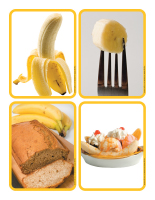
Prepare all kinds of banana-based recipes with your group. For example, you can make muffins, cake, bread, milkshakes, etc.
My jungle snack
Use green food coloring to color coconut. Set your green coconut in a bowl to represent grass. Add animal cookies and serve at snack time.
ARTS & CRAFTS
Puppets-Monkeys
(Open puppets-Monkeys) Print the models on heavy paper. Have children cut them out and decorate them. Attach Popsicle sticks to the back of each model to make puppets.
Models-Monkeys
(Open models-Monkeys) Print. Use the models as a starting point for various crafts and projects.
My fun monkey
(Open my fun monkey) Print the various pieces. You will need 2 paper plates (a small one and a bigger one) for each child. Have them paint their plates using beige or brown poster paint. They will represent a monkey body and head. Children assemble their monkey by gluing the various monkey body parts (face, tail, legs, ears) and the banana on the plates. Hang the assembled monkeys from the ceiling.
Monkey footprints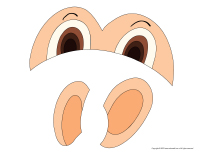
Paint the sole of each child’s foot using brown poster paint and press it on a piece of paper, with the toes pointing downwards. Their heel will become the head of their monkey whereas their toes will represent monkey legs. Using a paintbrush, children can add a monkey tail. They can then draw details on their monkey’s face and monkey ears using a black marker. Older children will enjoy adding a palm tree next to their monkey. They can press their finger in brown poster paint and make several impressions, one on top of the other to represent a palm tree trunk before pressing their finger in green poster paint and then on the paper to draw palm tree leaves.
Monkey face
(Open monkey face) Print for each child. First, ask children to paint a paper plate using brown poster paint. While the paint is drying, have them cut out the different parts of their monkey face and color them. Once the paint is completely dry, they can complete their monkey face by gluing the items in place.
COLORING PAGES
(Open coloring pages-Monkeys) Print for each child.
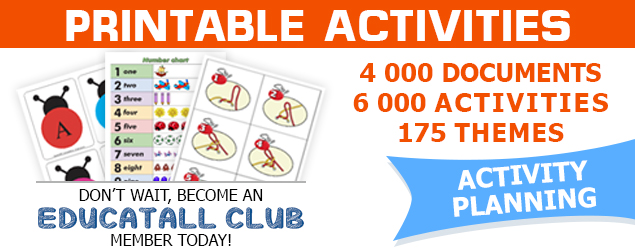
 Home
Home Theme activities
Theme activities
 Babies and toddlers
Babies and toddlers
 Arts and crafts
Arts and crafts
 Science
Science
 Creative recipes
Creative recipes
 Tips and tricks
Tips and tricks
 Special needs
Special needs
 Extra activities
Extra activities
 Educ-TV
Educ-TV
 Newsletter
Newsletter  Online store
Online store Educatall club
Educatall club


